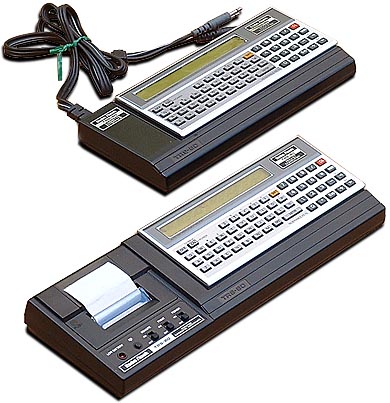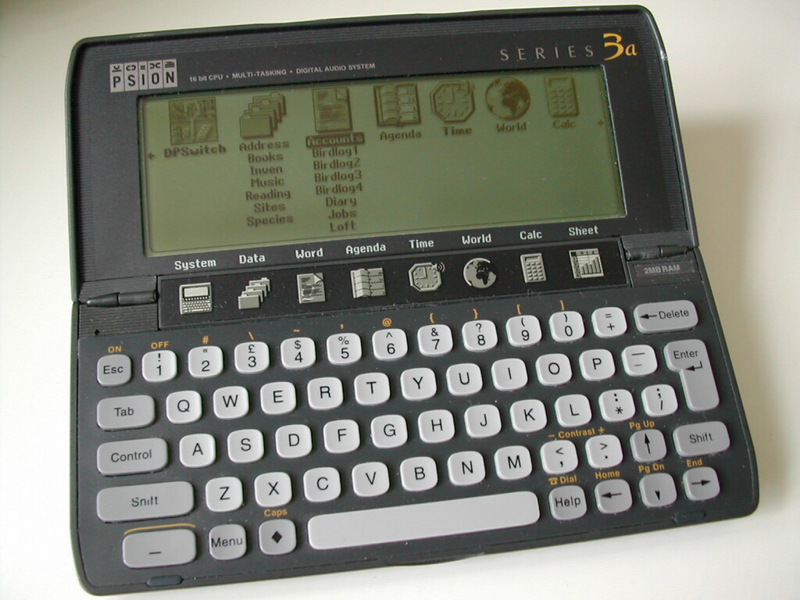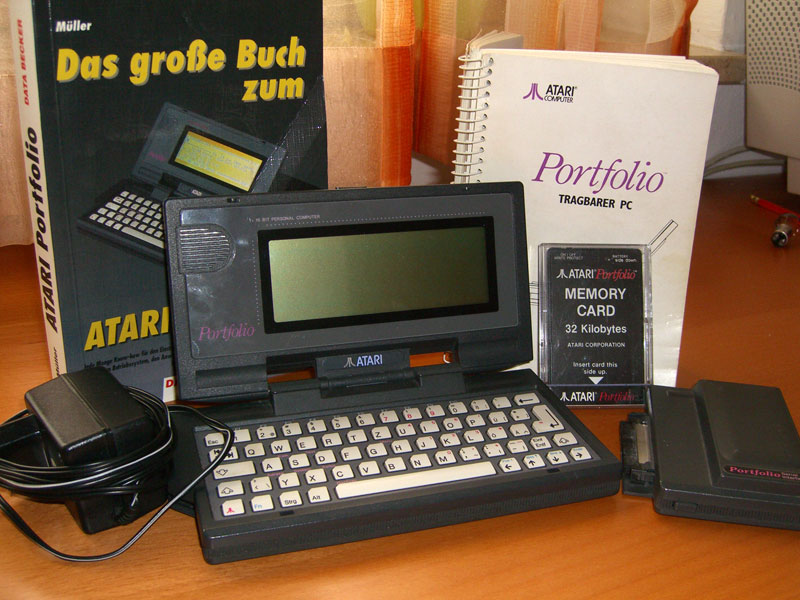The history of handheld computers in faces. Part 1
My first article on Habrahabr was devoted to the history of mobile operating systems . This post is a kind of photo - addition to it.
Warning: a lot of pictures.
The first handheld computer
The first handheld computer can be considered Radio Shack Pocket Computer TRS - 80, released in July 1980.

Figure 1. Radio Shack Pocket Computer TRS - 80
This device weighed 170 grams, had a SC43177 or SC43178 processor, carried 1.5 KB of RAM. Information was displayed on a 24x1 text LCD display and / or text tape with a printer, purchased separately for $ 149. The "computer" itself cost $ 230. As an operating system, he had a Basic language interpreter built into the ROM.
Age of Psion
The next milestone in the development of handheld computers was the device released by the English company Psion in 1984. It was Psion Organizer 1, which gave rise to a whole era of electronic organizers, and then Psion Series 3 and Psion Series 5 handheld computers.

Figure 2. Psion Organizer 1
Outwardly it looked like a brick and fit in the palm of your hand, it had a processor with a clock speed of 0 , 92 MHz, 2 kB of memory and two slots for installing extension cartridges, 16-character alphanumeric screen, 37-key keyboard. This device combined the functions of several devices at once: a clock, a calculator and a notebook.
In 1986, an updated version of Psion Organizer 2 was released, which had an improved keyboard and display. RAM was also added, there were versions with 8 and 16 KB of RAM.

Figure 3. Psion Organizer 2
Psion 3 (1993) was, in fact, the first real pocket computer company created to replace the paper diary and notepad with their electronic version. In addition to the organizer, the standard set of applications included a text editor and spreadsheet editor, a database, world time, etc.
Psion developed its own programming language (OPL), which allows you to create applications that use all the capabilities of a computer.

Figure 4.Psion Series 3
The dimensions of the device are as follows - 165 x 85 x 22 mm. Power was supplied from 2 finger batteries (type AA). Due to the lack of non-volatile memory, a backup “tablet” battery was used to save data at the time of changing the batteries. The handheld had a connector for connecting a network adapter. The display in the device was monochrome and had a resolution of 480 × 160. To enter information, a laptop-type QWERTY keyboard was used. The updated versions of the model had a built-in microphone. The device supported memory cards format Psion Solid State Disks.
As the operating system in the PDA used 16 - bit EPOC16.
Psion Series 5 (1998) was the next step in the development of Psion laptop computers (Psion 4 did not enter the market). Series 5 case is made of hard plastic and is divided into two parts (touch screen and keyboard), interconnected by a cable and rails, which allows you to freely open and close the device.

Figure 5. Psion Series 5
Device dimensions: 17.0 × 9.0 × 2.3 cm. Weight: 350 g (with batteries).
A 32-bit ARM7100 processor (RISC type) was installed in the device. Its clock frequency was 18 MHz. Versions with 4 and 8 MB of RAM were delivered. Later there was a version of Series 5mx with an ARM710T processor (36 MHz). There are editions with 16, 24 or 32 MB of RAM.
The device, like its predecessor, was powered by two finger-type batteries. Operating time was 35 hours. The laptop computer could work from a network. It also lacked non-volatile memory, forcing the use of a “tablet” as a backup power when changing batteries. Screen resolution has been increased - now it was 640 × 240.

Figure 6. Comparison of the Psion Series 5 and Nokia E90
As an operating system, the PDA now uses 32-bit EPOC32. It was preinstalled with programs for working with text documents, spreadsheets, e-mail (R3, R5), notes, browser (R3, R5), address book (R5), organizer, database, calculator, graphic editor, voice recorder, terminal , development environment for the OPL programming language, Java Virtual Machine (R5), a desktop synchronization application. The Opera 3.62 browser was also bundled with some devices.
MS - DOS comes to the mobile market
"You can make a cat linger in the oven, but kittens will not become cookies from this." No matter how manufacturers of the 80s called their devices, all of them will remain only highly pumped programmable calculators.
The situation changed in 1989 when Portfolio Portable, running DIP DOS (an analogue of MS DOS 2.11), was presented at the COMDEX exhibition.

Figure 7. Atari Portfolio Portable
It was equipped with an Intel 80C88 processor with a clock frequency of 4.9152 MHz. RAM, there were 128 KB, and ROM - 256 KB. Three AA AA batteries were used as a power source. Also, the device could work from the network.
Although DIP - DOS is mostly compatible with MS - DOS 2.11, some DOS 2.xx functionality is missing. However, some internal data structures are more compatible with MS-DOS 3.xx.
Warning: a lot of pictures.
The first handheld computer
The first handheld computer can be considered Radio Shack Pocket Computer TRS - 80, released in July 1980.

Figure 1. Radio Shack Pocket Computer TRS - 80
This device weighed 170 grams, had a SC43177 or SC43178 processor, carried 1.5 KB of RAM. Information was displayed on a 24x1 text LCD display and / or text tape with a printer, purchased separately for $ 149. The "computer" itself cost $ 230. As an operating system, he had a Basic language interpreter built into the ROM.
Age of Psion
The next milestone in the development of handheld computers was the device released by the English company Psion in 1984. It was Psion Organizer 1, which gave rise to a whole era of electronic organizers, and then Psion Series 3 and Psion Series 5 handheld computers.

Figure 2. Psion Organizer 1
Outwardly it looked like a brick and fit in the palm of your hand, it had a processor with a clock speed of 0 , 92 MHz, 2 kB of memory and two slots for installing extension cartridges, 16-character alphanumeric screen, 37-key keyboard. This device combined the functions of several devices at once: a clock, a calculator and a notebook.
In 1986, an updated version of Psion Organizer 2 was released, which had an improved keyboard and display. RAM was also added, there were versions with 8 and 16 KB of RAM.

Figure 3. Psion Organizer 2
Psion 3 (1993) was, in fact, the first real pocket computer company created to replace the paper diary and notepad with their electronic version. In addition to the organizer, the standard set of applications included a text editor and spreadsheet editor, a database, world time, etc.
Psion developed its own programming language (OPL), which allows you to create applications that use all the capabilities of a computer.

Figure 4.Psion Series 3
The dimensions of the device are as follows - 165 x 85 x 22 mm. Power was supplied from 2 finger batteries (type AA). Due to the lack of non-volatile memory, a backup “tablet” battery was used to save data at the time of changing the batteries. The handheld had a connector for connecting a network adapter. The display in the device was monochrome and had a resolution of 480 × 160. To enter information, a laptop-type QWERTY keyboard was used. The updated versions of the model had a built-in microphone. The device supported memory cards format Psion Solid State Disks.
As the operating system in the PDA used 16 - bit EPOC16.
Psion Series 5 (1998) was the next step in the development of Psion laptop computers (Psion 4 did not enter the market). Series 5 case is made of hard plastic and is divided into two parts (touch screen and keyboard), interconnected by a cable and rails, which allows you to freely open and close the device.

Figure 5. Psion Series 5
Device dimensions: 17.0 × 9.0 × 2.3 cm. Weight: 350 g (with batteries).
A 32-bit ARM7100 processor (RISC type) was installed in the device. Its clock frequency was 18 MHz. Versions with 4 and 8 MB of RAM were delivered. Later there was a version of Series 5mx with an ARM710T processor (36 MHz). There are editions with 16, 24 or 32 MB of RAM.
The device, like its predecessor, was powered by two finger-type batteries. Operating time was 35 hours. The laptop computer could work from a network. It also lacked non-volatile memory, forcing the use of a “tablet” as a backup power when changing batteries. Screen resolution has been increased - now it was 640 × 240.

Figure 6. Comparison of the Psion Series 5 and Nokia E90
As an operating system, the PDA now uses 32-bit EPOC32. It was preinstalled with programs for working with text documents, spreadsheets, e-mail (R3, R5), notes, browser (R3, R5), address book (R5), organizer, database, calculator, graphic editor, voice recorder, terminal , development environment for the OPL programming language, Java Virtual Machine (R5), a desktop synchronization application. The Opera 3.62 browser was also bundled with some devices.
MS - DOS comes to the mobile market
"You can make a cat linger in the oven, but kittens will not become cookies from this." No matter how manufacturers of the 80s called their devices, all of them will remain only highly pumped programmable calculators.
The situation changed in 1989 when Portfolio Portable, running DIP DOS (an analogue of MS DOS 2.11), was presented at the COMDEX exhibition.

Figure 7. Atari Portfolio Portable
It was equipped with an Intel 80C88 processor with a clock frequency of 4.9152 MHz. RAM, there were 128 KB, and ROM - 256 KB. Three AA AA batteries were used as a power source. Also, the device could work from the network.
Although DIP - DOS is mostly compatible with MS - DOS 2.11, some DOS 2.xx functionality is missing. However, some internal data structures are more compatible with MS-DOS 3.xx.
